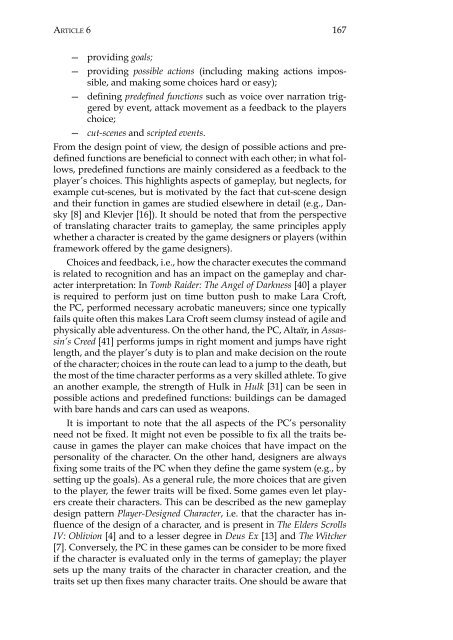Character Driven Game Design
Character Driven Game Design
Character Driven Game Design
You also want an ePaper? Increase the reach of your titles
YUMPU automatically turns print PDFs into web optimized ePapers that Google loves.
Article 6 167<br />
——<br />
providing goals;<br />
——<br />
providing possible actions (including making actions impossible,<br />
and making some choices hard or easy);<br />
——<br />
defining predefined functions such as voice over narration triggered<br />
by event, attack movement as a feedback to the players<br />
choice;<br />
——<br />
cut-scenes and scripted events.<br />
From the design point of view, the design of possible actions and predefined<br />
functions are beneficial to connect with each other; in what follows,<br />
predefined functions are mainly considered as a feedback to the<br />
player’s choices. This highlights aspects of gameplay, but neglects, for<br />
example cut-scenes, but is motivated by the fact that cut-scene design<br />
and their function in games are studied elsewhere in detail (e.g., Dansky<br />
[8] and Klevjer [16]). It should be noted that from the perspective<br />
of translating character traits to gameplay, the same principles apply<br />
whether a character is created by the game designers or players (within<br />
framework offered by the game designers).<br />
Choices and feedback, i.e., how the character executes the command<br />
is related to recognition and has an impact on the gameplay and character<br />
interpretation: In Tomb Raider: The Angel of Darkness [40] a player<br />
is required to perform just on time button push to make Lara Croft,<br />
the PC, performed necessary acrobatic maneuvers; since one typically<br />
fails quite often this makes Lara Croft seem clumsy instead of agile and<br />
physically able adventuress. On the other hand, the PC, Altaïr, in Assassin’s<br />
Creed [41] performs jumps in right moment and jumps have right<br />
length, and the player’s duty is to plan and make decision on the route<br />
of the character; choices in the route can lead to a jump to the death, but<br />
the most of the time character performs as a very skilled athlete. To give<br />
an another example, the strength of Hulk in Hulk [31] can be seen in<br />
possible actions and predefined functions: buildings can be damaged<br />
with bare hands and cars can used as weapons.<br />
It is important to note that the all aspects of the PC’s personality<br />
need not be fixed. It might not even be possible to fix all the traits because<br />
in games the player can make choices that have impact on the<br />
personality of the character. On the other hand, designers are always<br />
fixing some traits of the PC when they define the game system (e.g., by<br />
setting up the goals). As a general rule, the more choices that are given<br />
to the player, the fewer traits will be fixed. Some games even let players<br />
create their characters. This can be described as the new gameplay<br />
design pattern Player-<strong>Design</strong>ed <strong>Character</strong>, i.e. that the character has influence<br />
of the design of a character, and is present in The Elders Scrolls<br />
IV: Oblivion [4] and to a lesser degree in Deus Ex [13] and The Witcher<br />
[7]. Conversely, the PC in these games can be consider to be more fixed<br />
if the character is evaluated only in the terms of gameplay; the player<br />
sets up the many traits of the character in character creation, and the<br />
traits set up then fixes many character traits. One should be aware that
















